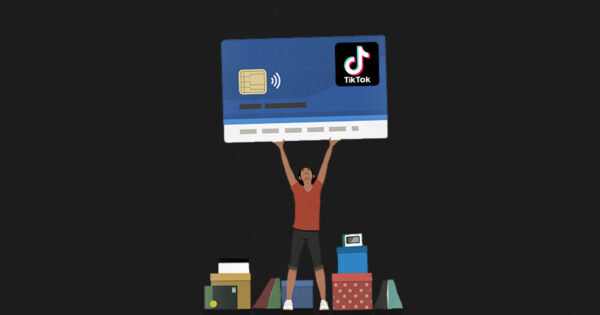It moves the entire shopping experience onto social media platforms, from finding and researching products to directly purchasing them. It integrates product showcases, in-platform brand pages and native checkout, all in one place. The obvious benefit to consumers is the uninterrupted social media content-viewing experience; they donât have to navigate to a separate ecommerce platform to make purchases.
TikTok has the potential to pull ahead of the pack due to its 150 million users and the overindexing among Gen Z and other younger shoppers. The typical Gen Z consumer spends 10 hours per week on TikTok but just 5 hours on Instagram, for example. Brands should note that TikTok has become increasingly attractive as a social commerce platform. Research firm IZEA reported that in 2021, 33% of consumers named Instagram the best platform versus 19% naming TikTok. In 2022, these positions were reversed, with 24% favoring Instagram and 31% TikTok.
However, TikTok Shop also has unique problems to navigate. Here, we look at the social commerce space as a whole and what to consider when investing in this next wave of the shopping experience.
The current state of social commerce
Social commerce is available on major platforms like Facebook, Instagram, Pinterest and TikTok, and itâll only continue to expand. EMarketer forecasts that social commerce revenues will total $82.8 billion in 2024, nearly doubling to $144.5 billion by 2027, and growing from 6.6% of total U.S. commerce sales to 8.4% in that same timeframe.
Gen Zâs increasing purchasing power, online behaviors, shopping preferences and personal opinions drive them to social commerce sites. Their purchasing power in 2023 totals approximately $360 billion, 5% of the U.S. economy. Thatâs more than any other generation, and that percentage is expected to grow to 17% by 2030. Gen Z will continue to grow as social network users, from approximately 60 million in 2024 to nearly 66 million in 2027, which is significantly faster than other generations.
TikTok Shop also aligns with the products Gen Z consumers tend to purchase. An International Council of Shopping Centers (ICSC) survey released earlier this year found that 48% of Gen Z frequently shop at discount stores or off-price retailers, 25% often shop at dollar stores, and just 9% shop at luxury retailers.
Gen Zâs attitudes about the U.S. economy and their financial situations are driving shopping behaviors. A Bank of America study from last fall found that 73% of Gen Z claimed the economy was making it difficult to save money, and 56% reported inflation had put stress on their finances.
Despite the promising forecast on Gen Z shopping habits, TikTok and other social commerce platforms are facing headwinds. According to the eMarketer report, annual growth in new social buyers is declining and expected to level off in the 2% range by 2025. Growth in per-capita social commerce sales is also expected to decrease from the 20% range today to 16% in 2027. Given current market dynamics, double-digit growth in social commerce may only be sustainable for the short term.
On top of that, TikTok Shop is expected to lose $500 million this year as parent company ByteDance invests in staff and infrastructure. Rumors about the abundance of cheap products remain rampant, with strong evidence that some products may be counterfeit. In just one example, a TikTok seller listed a face serum as available for $5 while the manufacturerâs listed price was $25. A TikTok spokesperson could not confirm whether the discounted serum was real and heavily discounted or fake.
TikTokâs parent company, China-based ByteDance, also raises significant data privacy concerns. The company delayed the public availability of TikTok Shop, which requires payment information, for several months due to concerns the U.S. government would issue an outright ban of TikTok. To address this in part, the company has separated U.S. consumer data from other customer data and stored it on servers within Oracleâs U.S. Cloud infrastructure located in the U.S. Still, the House of Representatives voted on a nationwide TikTok ban as recently as March 2024, with its fate in the Senate to be determined.
Where is there opportunity?
You have to look at the secular trends in the industry to understand the opportunity ahead for social commerce.
Easy access to technology, low-cost capital and the human drive to create have contributed to the growth of startups. The âcreator economyâ is thriving and accelerated by the explosion of new products and services. According to Goldman Sachs, there are over 300 million content creators, and the creator economy is expected to reach $480 billion by 2027. If you believe in the entrepreneurial spirit and the prospects of the creator economy, you have to believe in the power of social commerce.
Social commerce has a compelling proposition for upcoming brands. Yet, it also must be recognized that great businesses and brands are not built through a single-dimensional engagement with the audience. While social commerce and TikTok may be a great starting point, building a sustainable business outside the âlatest trendâ is about finding your audience across all channels and engaging them across their journey of awareness, research and consideration.
Great business strategy and marketing will challenge brands to be present across all channels and modalities, spanning display advertising, social media, connected TV, email/SMS and AR/VR as it becomes more mainstream. Leveraging every one of these strategies in your mix is not the answer, but neither is using just one of them.
So whatâs the prognosis for TikTok Shop?
It may take time, but it will likely be highly successful in the U.S. market due to its growth and appeal to a younger demographic. From 2021 to 2027, the number of TikTok Shop buyers will increase by more than 350%, while Instagram buyers will increase by 145%, and the Facebook buyer base will expand by 122%.

In addition to the large number of Gen Z users already taking advantage of TikTokâs features, there are other factors to consider. Younger shoppers place value on convenience and the ability to make purchases without needing to visit multiple platforms. The appeal also depends on the type of products being offered and their prices, with trendy, lower-cost items typically requiring less consideration before purchasing.
Younger shoppers also have different views about data privacy. While they are significantly concerned about revealing their personal information online, theyâre much more relaxed about being tracked by websites or apps. Finally, despite recent rhetoric, the U.S. government is reluctant to restrict trade and commerce by banning platforms or other technologies without near airtight evidence that they pose a national security threat.
Social commerce is a rapidly maturing means for brands and retailers to market their products. TikTok has distinct advantages over other platforms when targeting Gen Z. Time will tell if the social platform continues its dramatic growth trajectory or succumbs to competitors and/or government pressure.





